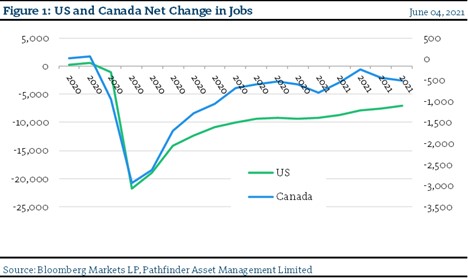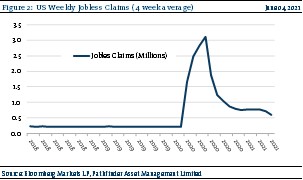US and Canadian Employment
The US and Canada release employment data on the first Friday of every month. Last month, we noted in our Pathfinder Investment Outlook that weak employment data led to financial asset volatility. Many market participants look to employment and inflation data as the prime barometers of the economic situation. Over the long-term, stock and bond markets tend to move in tandem with the economy; however, there are times over the short and medium-term where valuations of financial assets can drift away from the economy, especially when major central banks are involved. For this reason, close attention is paid to employment and wage data as an indicator of overall economic health. This month’s report was anticipated because the data last month was surprisingly poor. For May, the US has bounced back with solid job growth. Canada, on the other hand, continues to struggle, with negative job growth again for a second month in a row.
- The US created 559k jobs last month which was much better than the 278k that it created the month before. It was also more in line with what economists were expecting. Cumulatively, the US has lost 7.3 million jobs since the pandemic started. There still remains a long path back, but sequential improvement continues. Canada, on the other hand, had two straight months of declines, also remains 500k jobs from full recovery. Figure 1 presents the data of both counties since Jan 2020.

- Figure 2 presents the higher frequency Weekly Jobless Claims data, which continues to post strong results and is approaching somewhat more normal numbers.

“This means that” we will continue to watch the employment situation carefully. While the aggregate data does show some improvement, there is still a long way to go. Furthermore, we are hearing anecdotal reports of labour shortages in several employment sectors that is creating wage inflation. Indeed, the pandemic has created major misallocations of resources and this is one sector that will take time to normalize.
National Instrument 31-103 requires registered firms to disclose information that a reasonable investor would expect to know, including any material conflicts with the firm or its representatives. Doug Johnson and/or Pathfinder Asset Management Limited are an insider of companies periodically mentioned in this report. Please visit www.paml.ca for full disclosures.
*All returns are time weighted and net of investment management fees. Returns from the Pathfinder Partners’ Fund and Partners’ Real Return Plus Fund are presented based on the masters series of each fund. The Pathfinder Core: Equity Portfolio and The Pathfinder Core: High Income Portfolio are live accounts. These are actual accounts owned by the Pathfinder Chairman (Equity) and client (High Income) which contain no legacy positions, cash flows or other Pathfinder investment mandates or products. Monthly inception dates for each fund and portfolio are as follows: Pathfinder Core: Equity Portfolio (January 2011), Pathfinder Core: High Income Portfolio (October 2012) Partners’ Fund (April 2011), Partners’ Real Return Plus Fund (April, 2013), and Partners’ Core Plus Fund (November 2014).
Pathfinder Asset Management Limited (PAML) and its affiliates may collectively beneficially own in excess of 10% of one or more classes of the issued and outstanding equity securities mentioned in this newsletter. This publication is intended only to convey information. It is not to be construed as an investment guide or as an offer or solicitation of an offer to buy or sell any of the securities mentioned in it. The author has taken all usual and reasonable precautions to determine that the information contained in this publication has been obtained from sources believed to be reliable and that the procedures used to summarize and analyze such information are based on approved practices and principles in the investment industry. However, the market forces underlying investment value are subject to sudden and dramatic changes and data availability varies from one moment to the next. Consequently, neither the author nor PAML can make any warranty as to the accuracy or completeness of information, analysis or views contained in this publication or their usefulness or suitability in any particular circumstance. You should not undertake any investment or portfolio assessment or other transaction on the basis of this publication, but should first consult your portfolio manager, who can assess all relevant particulars of any proposed investment or transaction. PAML and the author accept no liability of any kind whatsoever or any damages or losses incurred by you as a result of reliance upon or use of this publication.